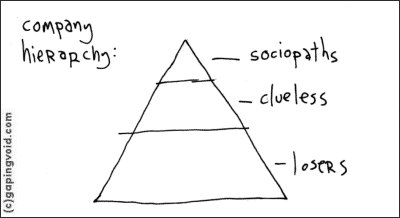A few days ago I wrote about the history of management, and specifically the Gervais Principle.The Gervais Principle states:
 Sociopaths, in their own best interests, knowingly promote over-performing losers into middle-management, groom under-performing losers into sociopaths, and leave the average bare-minimum-effort losers to fend for themselves.
Sociopaths, in their own best interests, knowingly promote over-performing losers into middle-management, groom under-performing losers into sociopaths, and leave the average bare-minimum-effort losers to fend for themselves.
This principle was based on this image of Company Hierarchy by Hugh MacLeod. This image is a take on the Peter Principle, or the idea that in a hierarchy a person will rise to his/her level of incompetence.
The Gervais Principle asserts that hierarchies are not the victim of the Peter Principle, but they create this crazy triangle of power out of necessity.
In the previous blog post, I bemoaned the fact that I am learning about the guys who wrote all the top down, command and control management theories in one of my classes this semester. So great – I’m learning the management schemes that prevent collaboration and innovation.
So maybe I should look at this from a performance standpoint. We know the actual performance state of many companies is this chart. We know this because of the popularity in comic devices such as Dilbert, Office Space, and The Office (which has a UK and US version, proving the triangle problem is global).
If this is the actual performance state, what would be the desired performance state of a company’s management system?
Polly Pearson blogged about an inverted triangle. Could this be the desired state?
I think this may be closer. Here is what she had to say:
Today, EMC is moving rapidly toward to the Inverted Pyramid, the one where everyone can have an idea, be passionate about it and facilitate success. We are transitioning from the world of one spiritual leader/mentor/motivator in a company to Many — all joined by community, customers, and a common goal. This is our 2009 Pyramid, reflective of the faces behind the best ideas from the more than 1,400 submitted by EMCers in 19 countries this past few months.
Here is my idea: manage the organization, from the inside out using value networks.
Take Polly’s inverted triangle, and build one for every organization in the company. Point all the smallest angles of the triangles at each other to form a circle. Put the executives in the middle of the circle, with connections to every part of the organization. Give the little guy like me a way to network and use our expertise to help the business.
I think it would look something like this image:

I need to work on that image, I know. Hopefully my idea comes across. What do you think? Does this sort of management principle already exist?
If we can agree that top-down, command and control management doesn’t work, we know we need to get rid of the triangle. Is my circle idea a desired performance state for management? If so, how do we get there?






I think that, first of all, you have to postulate a world that is not populated entirely of sociopaths, the clueless, and losers.
I think the definition of “losers” in the triangle isn’t the Western definition (the L on the forehead type), but an economic definition. So losers in the economic sense…you lose the economic potential you may have in order to gain a sense of security.
Although I do believe the world is not entirely populated with losers.
Gina –
I heard about you through Systers. loved your blog and this statement
My long-term professional goal is to own a company that offers a blended solution of Enterprise Collaboration and Education to non-profit and small companies.
I think we may have some things in common
Shanna I love the name of your blog! Besides tech writing, what else do we have in common?